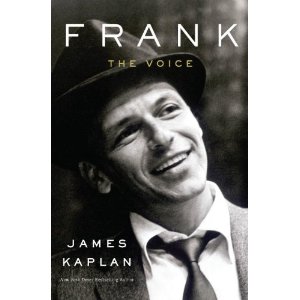Paul O’Connor has discovered that a new book about “The Voice” reveals a lot about Sinatra the man.
By Paul T. O’Connor
FRANK: THE VOICE. By James Kaplan. Doubleday. 718 pages. $35, hardcover.
Siriously Sinatra, the satellite radio station dedicated to American standards, occasionally plays a live cut that contemporary listeners probably find offensive but which likely represented a small social breakthrough at the time, probably the early 1960s.
Sammy Davis Jr., Dean Martin and Frank Sinatra appear on the live nightclub recording, and they exchange racial jests that would be socially unacceptable now.
The first time I heard the cut, I shook my head, reminded of how common such stereotypes were at the time, jests similar to the ethnic jabs my high school friends and I threw at each other in the 1960s. The second time, I tried to put the jesting in context, something always worthwhile when considering the past.
For boomers who know only the conservative Sinatra of the Nixon era and later, James Kaplan’s biography of the crooner’s first 40 years – 1915 to 1954 – will come as quite a surprise. Sinatra was a liberal in his early years, a man who openly supported Franklin Roosevelt, Jack Kennedy and Adlai Stevenson, who was simpatico with the socially repressed and poor and who, very much, abhorred racism.
So let’s reconsider his and Dino’s gentle jesting with the classic “Negro song-and-dance” minstrel Davis. Let’s think of the likely all white, all mature, all affluent and conservative greatest-generation audience that was sitting in that club. And let’s put Sinatra in context.
Here was the most important, popular and, in my opinion, talented white male entertainer of the 20th century putting his arm around a black colleague and telling the audience that it was OK to have a black man as a best friend. And, furthermore, telling that audience that the assembled talent in the orchestra, I’m guessing it was Count Basie’s, was unmatched in the world – even if it was mostly black.
And that interpretation would be much more consistent with the Sinatra who really lived than with any Sinatra-like character depicted in any novel. (Yes, I’m referring to Mario Puzo’s The Godfather.) It’s the Sinatra supported by the historical record.
Kaplan’s biography is most compelling in the subchapters covering this Sinatra of substance, whether his attitudes about race, politics, social equity or the arts. His reporting on Sinatra in the recording studio, a genius when it came to mixing sounds, is spectacular.
The book gets dull, unexpectedly, when it focuses on Sinatra’s unquenchable sex drive, drinking, partying and financial excesses. There are only so many times I care to read about the new showgirl he picked up for a night, or the latest party where he went berserk, etc.
And, as for Ava Gardner, well, any bloom on that rose – in my impression of her – is certainly gone. She was no better than Sinatra, maybe worse. I can’t imagine how the blue-haired ladies at the Ava Gardner museum in Smithfield explain away her behavior. (But I’m sure I’ll visit the place some day to find out.)
Kaplan has been a successful writer, and his research for this book was quite good. This is not some celebrity rip off, thrown together based on rumors. He provides extensive notes at the end, and he cites his source in the text when it is essential to do so. Still, his copy does not sing, his prose doesn’t excite. And the reader won’t get the impression that Kaplan is especially fond of Sinatra, or vice versa, except that he does concede the man’s artistic genius.
At several points, Kaplan refers to situations in which Sinatra could have been killed, either when he slit his wrist, took a dangerous air flight or drove recklessly. Had he died late in his first 40 years, the author states, Sinatra would surely be remembered, but not as the great artist, the best at his craft in a century of American public culture. It is what happened after Sinatra won the Oscar for his role in From Here to Eternity and the music he made with Nelson Riddle after 1953 that set him aside in our pantheon. And that’s where this book ends. Let’s hope that story comes in a Kaplan sequel.
- Paul T. O’Connor, contributing editor, is a university lecturer who is available for freelance writing assignments. Contact him at ocolumn@gmail.com.
